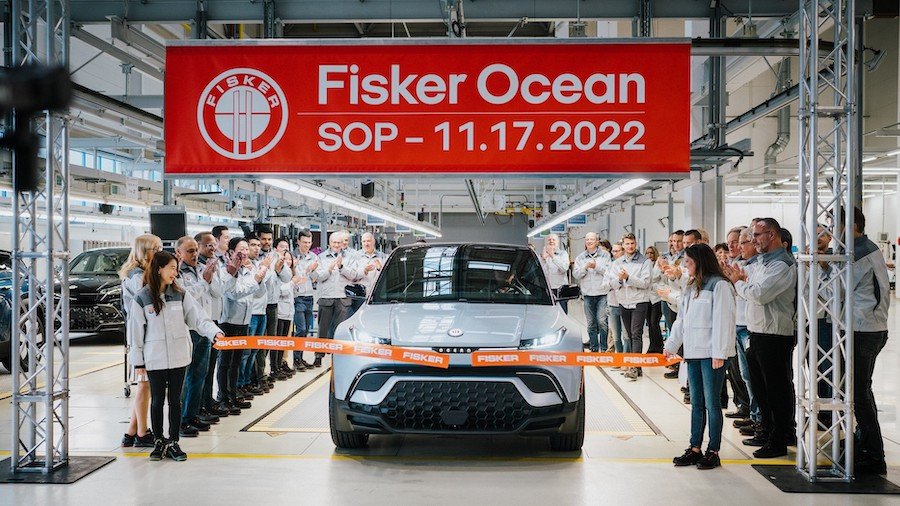Fisker Files For Reorganization In Austria After Magna Pauses Ocean Production

Fisker Files For Reorganization In Austria After Magna Pauses Ocean Production
It’s the rough equivalent of filing for Chapter 11 bankruptcy protection in the United States. What's next for the troubled startup?
The Austrian arm of troubled EV maker Fisker has filed for reorganization, the company said in a statement yesterday. The decision comes after Magna Steyr, the Austrian contract manufacturer that built the Ocean EV, idled the production of Fisker’s sole vehicle earlier this week.
Fisker Austria “has voluntarily filed to open a restructuring proceeding via self-administration under the Austrian Insolvency Code,” the automaker said in its statement, adding that the proceeding will enable the Austrian entity “to ensure its operations are able to continue under court protection, including paying employees and selling vehicles.” The development was first reported by Germany's Automobilwoche.
The reorganization is roughly equivalent to filing for Chapter 11 bankruptcy in the United States, a move that the company said it would pursue if additional funding is not secured. In the latest 10-K form filed with the Securities and Exchange Commission last month, Fisker said it had roughly $50 million left in the bank.
Last year, the Henrik Fisker-led EV startup burned through roughly $70 million per month on average. If the spending remains unchanged, simple maths tells us that the company will run out of money by the end of May.
“A self-administered restructuring proceeding allows Fisker Austria to protect its business while it conducts a value-maximizing strategic transaction or other sale of assets,” the firm said in its statement from yesterday, adding that the company’s other entities are not included in the Austrian restructuring proceedings and operate normally.
“Fisker Austria intends to continue delivering its vehicles to customers to the extent possible, providing service, and updating its over-the-air software as it moves through the restructuring proceedings,” the European arm of the California-based company said in the statement.
Magna Steyr, a division of Canada-based Magna International, has built roughly 11,000 Ocean EVs for Fisker since starting production at its Graz, Austria factory in November 2022. Originally, Fisker planned on building 20,000 to 23,000 Ocean crossovers per year, but production was halted in March as the inventory swelled to almost 5,000 cars.
Fisker's approach to building EVs was called "asset-light" by the company, meaning that at least initially, it planned to lean on outside, contracted factories to build its cars. In theory, Fisker said that would keep overall costs and capital expenditures down so it could focus on design, technology and the customer experience. (Unfortunately, the latter has not been great as of late for Fisker owners, according to accounts given to InsideEVs.)
The same Magna Steyr factory assembles the BMW 5 Series, Jaguar I-Pace, Jaguar E-Pace, BMW Z4, Toyota Supra and Mercedes-Benz G-Class. However, the discontinuation of multiple models by the end of the year prompted Magna to lay off 500 people as it prepares for tough times. “The next three years will be very difficult in Graz,” Magna Steyr CEO Roland Prettner said for the Kleine Zeitung newspaper, quoted by Automotive News.
60%: Magna Lays Off 500 Workers After Fisker Production Pause
Following the latest round of Fisky business, Magna has announced that it will lay off 500 workers as the auto industry cools according to a report from Automotive News.
Originally, Magna anticipated manufacturing between 20,000 and 23,000 Fisker Oceans each year. In 2023, it built just about 10,000 units. With the pause of Ocean production remaining into the foreseeable future, the annual output reduction equates to nearly a quarter of Magna's current annual production output. For comparison, the company's 2023 Q4 output was 21,400 vehicles across all of its contracts. Magna expects to take a $400 million hit for 2024 revenue now that Fisker may be circling the drain.
But it's not just Fisker to blame this time. Although Magna has officially pressed pause on the production of the Fisker Ocean, it isn't the only vehicle that will end its product lifecycle this year. Magna also builds the BMW 5-Series, Jaguar E-Pace, and Jaguar I-Pace—all of which will end their product lifecycles at the end of this model year. From a forward-looking perspective, the BMW Z4 and Toyota Supra sister cars will end production in 2026.
"The next three years will be very difficult in Graz," said Magna Steyr CEO Roland Prettner in an interview with Austria's Kleine Zeitung. He continued, noting that the company expects to recover with additional contracts after that time.
The reality for Magna is a bit eye-opening. The company originally anticipated a sharp uptick in manufacturing as new EVs enter the space, especially given its potential annual production capacity of 150,000 vehicles. However, new contracts haven't materialized, and that includes work for legacy OEMs that it's already doing business with, like BMW.
Related News
